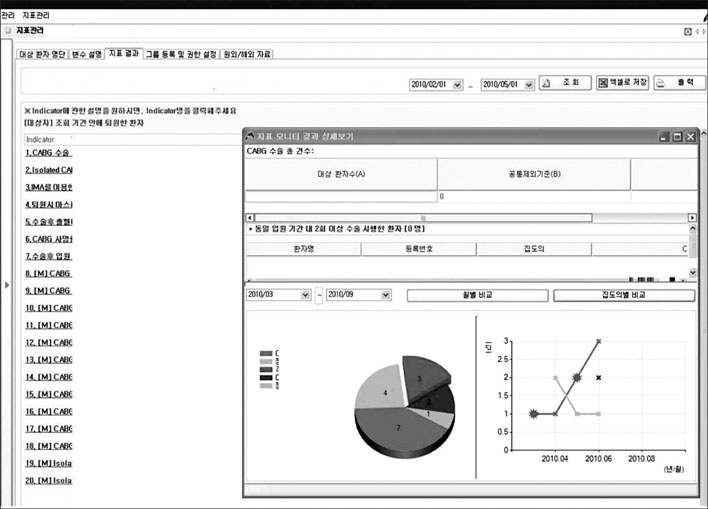Healthc Inform Res.
2010 Sep;16(3):191-197. 10.4258/hir.2010.16.3.191.
Asan Medical Information System for Healthcare Quality Improvement
- Affiliations
-
- 1Medical Information-Administration Team, Asan Medical Center, University of Ulsan College of Medicine, Seoul, Korea.
- 2Medical Information Office, Asan Medical Center, University of Ulsan College of Medicine, Seoul, Korea. rufiji@gmail.com
- 3Deptartment of Pulmonology, Asan Medical Center, University of Ulsan College of Medicine, Seoul, Korea.
- 4Deptartment of Emergency Medicine, Asan Medical Center, University of Ulsan College of Medicine, Seoul, Korea.
- 5Medical Information-Development Team, Asan Medical Center, University of Ulsan College of Medicine, Seoul, Korea.
- 6Medical Information-Management Team, Asan Medical Center, University of Ulsan College of Medicine, Seoul, Korea.
- KMID: 2284532
- DOI: http://doi.org/10.4258/hir.2010.16.3.191
Abstract
OBJECTIVES
This purpose of this paper is to introduce the status of the Asan Medical Center (AMC) medical information system with respect to healthcare quality improvement.
METHODS
Asan Medical Information System (AMIS) is projected to become a completely electronic and digital information hospital. AMIS has played a role in improving the health care quality based on the following measures: safety, effectiveness, patient-centeredness, timeliness, efficiency, privacy, and security.
RESULTS
AMIS consisted of several distinctive systems: order communication system, electronic medical record, picture archiving communication system, clinical research information system, data warehouse, enterprise resource planning, IT service management system, and disaster recovery system. The most distinctive features of AMIS were the high alert-medication recognition & management system, the integrated and severity stratified alert system, the integrated patient monitoring system, the perioperative diabetic care monitoring and support system, and the clinical indicator management system.
CONCLUSIONS
AMIS provides IT services for AMC, 7 affiliated hospitals and over 5,000 partners clinics, and was developed to improve healthcare services. The current challenge of AMIS is standard and interoperability. A global health IT strategy is needed to get through the current challenges and to provide new services as needed.
Keyword
MeSH Terms
Figure
Cited by 2 articles
-
Lessons Learned from Development of De-identification System for Biomedical Research in a Korean Tertiary Hospital
Soo-Yong Shin, Yongman Lyu, Yongdon Shin, Hyo Joung Choi, Jihyun Park, Woo-Sung Kim, Jae Ho Lee
Healthc Inform Res. 2013;19(2):102-109. doi: 10.4258/hir.2013.19.2.102.Going Abroad of Korean Health Information Systems
Young Moon Chae
Healthc Inform Res. 2014;20(3):161-162. doi: 10.4258/hir.2014.20.3.161.
Reference
-
1. Choi IY, Choi R, Lee JH, Choi BG. Implementation of single source based hospital information system for the Catholic Medical Center affiliated hospitals. Healthc Inform Res. 2010. 16:133–139.
Article2. Institute of Medicine (US) Committee on Quality of Health Care in America. Crossing the quality chasm: a new health system for the 21st century. 2001. Washington, DC: National Academy Press.3. Agren M, Winther D. Managing the internal IT function's changing role when outsourcing [Internet]. cited at 2010 Sep 2. Available from: http://arc.hhs.se/download.aspx?MediumId=291.4. Federico F. Preventing harm from high-alert medications. Jt Comm J Qual Patient Saf. 2007. 33:537–542.
Article5. Kohn LT, Corrigan J, Donaldson MS. To err is human: building a safer health system. 2000. Washington, DC: National Academy Press;86–108.6. Aspden P, Corrigan JM, Wolcott J, Erickson SM. Patient safety: achieving a new standard for care. 2003. Washington DC: National Academy Press;1–28.7. Bates DW, Cohen M, Leape LL, Overhage JM, Shabot MM, Sheridan T. Reducing the frequency of errors in medicine using information technology. J Am Med Inform Assoc. 2001. 8:299–308.
Article8. Freudenheim M. Many hospitals resist computerized patient care [Internet]. The New York Times. 2004. 04. 06. cited at 2010 Sep 2. Available from: http://www.nytimes.com/2004/04/06/business/many-hospitals-resist-computerized-patient-care.html.9. Demski H, Hildebrand C, Brass A, Jedamzik S, Engelbrecht R. Improvement of cross-sector communication in the integrated health environment. Stud Health Technol Inform. 2010. 155:95–100.
- Full Text Links
- Actions
-
Cited
- CITED
-
- Close
- Share
- Similar articles
-
- Smart Information System for Gachon University Gil Hospital
- Principles of quality management in medical imaging
- Understanding of the new Korea Healthcare Accreditation System
- Establishment, Present Condition, and Developmental Direction of the New Korean Healthcare Accreditation System
- Management and perspectives of patient safety in healthcare





